by Dorothea
Burstyn
(click on photos to enlarge image)
DON WALLACE, A LEADING FLATWARE DESIGNER AND AMBOSS, AN
INNOVATIVE AUSTRIAN FLATWARE MANUFACTURER
Two interesting lectures at the Solingen flatware collectors’
meeting 2010
This year's flatware collectors meeting at the Solingen
Klingenmuseum, planned and executed by director Dr. Barbara
Grotkamp-Schepers with her usual energy and charm, was again a
complete success. This year's motto could have been "The
productive 1950s-70s", as Dr. William P. Hood Jr. spoke about
Don Wallance and Jörg Müller-Daehn presented his and Heinrich
Averwerser's research on the output of Ambosswerke, Austria, in
the same time period.
Dr. W. P. Hood Jr., author of the definitive book on Tiffany
flatware (note 1) and numerous
articles on American 19th century flatware, has recently turned
his interest to the 20th and 21st century flatware production.
Since then, he has built up an extensive and comprehensive
collection of important modern flatware. When asked to hold a
lecture on Don Wallance, he studied the related Wallance papers
at the Cooper Hewitt Museum, New York, and also built up a
sample collection of all Wallance's flatware designs, which are
currently on display at the museum.
Don Wallance, graduating with a BA in English
Literature, became interested in modern design during
a Europe trip in 1932, and subsequently enrolled in
Design Laboratory in New York City, the first US
design school based on the Bauhaus model. Here his
attitude toward design - a strict catering to
consumers and their needs - was formed. In 1949, he
moved to Croton-on-Hudson, NY, where he established
his independent industrial design practice.
|
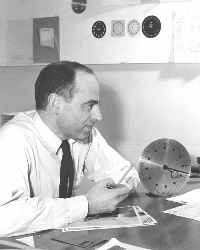 |
| |
Don Wallance
|
Wallance had success with his furniture designs
but concentrated mainly on tableware. From the early
1950s on he created fourteen flatware patterns for
H. E. Lauffer Co., of New York/New Jersey
(note 2).
Design One was made by the German firm Pott/Solingen
as no American firm could be found who would have
been able to execute the pattern's monoblock knife
to Wallance's satisfaction.
Design One enjoyed a long lasting popularity (in
Germany it was marketed as 2721).
Pott submitted a modified version of Design One to
Lufthansa and secured long-term contracts for
supplying this pattern as in-flight flatware for the
airline.
The relationship Pott/ Wallance was not always
harmonious; Pott entered Design One at the 1954
Milan Triennale and won a Gold Medal for the design
but never even bothered to tell Wallance about it.
|
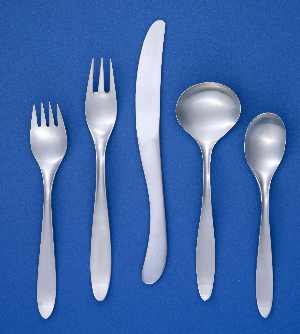 |
| |
Design One by Don Wallance,
manufactured by Pott/Germany, 1953
|
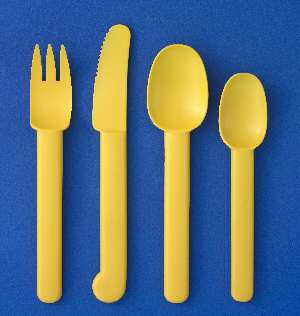 |
For Design One as for all his other flatware
designs Don Wallance started with wax and clay
models, these were followed by other models in
plaster and a soft metal alloy until the optimal
ergonomic forms were reached.
Most of his designs were executed in Europe and
marketed both there and in the US, an exception
being the all plastic Design 10.
Produced only in the U.S., Design 10 was made in a
variety of cheerful colors, not meant as disposable
but as the first ever-lasting, high quality plastic
flatware.
Wallance chose a special resin - Lexan - which was
strong enough to cut through meat and vegetables.
This innovative pattern was included in the 1983
Philadelphia Museum of Art's exhibition, Design
Since 1945.
|
|
Don Wallance all plastic Design 10, 1981
|
|
While Design One and Design Two received the
most critical acclaim Magnum was the most
commercially successful.
Don Wallance favorite material for flatware was
stainless steel, which he sometimes combined with
other materials - i.e. rosewood and plastic.
Don Wallance can be merited with making stainless
steel socially acceptable in America - one could say
that his excellent designs brought stainless steel
from the kitchen into the dining room.
His designs also led to the flatware industry's wide
acceptance of the monoblock knife.
|
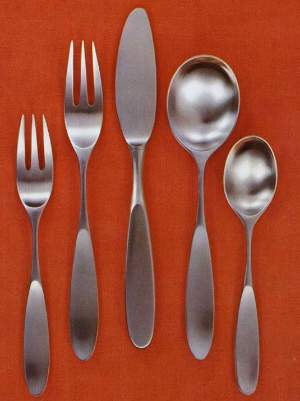 |
| |
Magnum, a commercial success,
Don Wallance 1970
|
Jörg Müller Daehn’s lecture on Amboss showed how good
management could transform a run-of-the-mill Austrian flatware
company into a vibrant innovative concern whose products earned
many prestigious prizes and were sold in more than sixty
different countries all over the world.
In the early 1950s Hans Malzacher bought Amboss and took the
daring decision to hire known designers such as Oswald Haerdtl
and Carl Auböck to work on modern pattern design. He also
believed in contracting young promising talents, many of whom
developed their first designs for Amboss: Janos Megyik, an
Austro-Hungarian painter and sculptor, Dominic von
Habsburg-Lothringen, German artist and designer Josef Überall,
the Austrian-Swedish designer couple Christel and Christer
Holmgren; Max Bailly and Max Kraft, teaming up as "max-design"
and most notably Austrian architect Helmut Alder.
Carl Auböck and his son designed Maestro (2060) in 1955/56 –
a slick design which is maybe more exciting for the eye than as
actual eating utensils. Nonetheless this pattern earned not only
the gold medal at the World Exhibition in Brussels 1958 but also
the Austrian state prize for good design. Helmut Alder designed
a number of very successful patterns for Amboss, starting with
2050 in 1954 which received the Stainless Steel Design Award,
Canada 1960 and numerous other prizes worldwide. Another
critically acclaimed pattern was Alder's 2070, , the dessert
version was used by Austrian Airlines for many years. The
anniversary flatware model 2200 by H. Alder was designed in
1967/68 and combined stainless steel with plastic – a pattern
which did not prove to be very practical as the black and red
dots kept falling out.
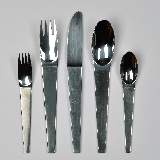 |
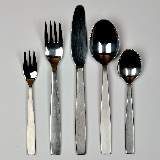 |
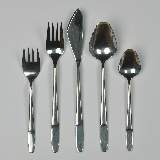 |
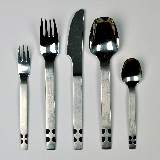 |
|
Maestro (2060),
Carl Auböck I and II,
1955
|
2050, Helmut Alder
1954
|
2070, Helmut Alder
1957
|
2200, Helmut Alder,
1967/68
|
It was also produced without the plastic inserts under the
same name (2200). Janos Megyik’s 1970 design 7000 for Amboss is
simply breathtakingly modern but also ergonomically pleasant.
Megyik designed a number of other utensils for Amboss, but none
of them are as revolutionary as 7000. Another far-out design is
the party dish K 70 equipped with a spork, designed by Ernst
Otto Loewe and K.H. Hoelscher circa 1970.
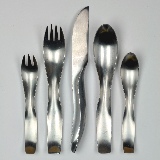 |
 |
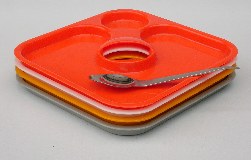 |
 |
|
7000, Janos Megyik, 1970
|
Snack flatware 1068,
Janos Megyik, ca. 1970
|
Party dish/tray and spork,
Ernst Otto Loewe
& K.H. Hoelscher, before 1970
|
spork, Ernst Otto Loewe & K.H. Hoelscher,
before 1970
|
The "Kinderbesteck 1060" by Joseph Überall and Dominic
Habsburg-Lothringen's "Hors d'oevre set" both designed
before1970 are shown here to further document the wide range of
exciting Amboss flatware. As an aside, it should be mentioned
that Amboss also showed great style sense in presenting their
wares. From 1958 to 1968 Amboss received nine Austrian state
prizes for excellent packaging (note 3).
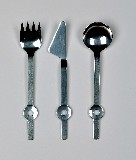 |
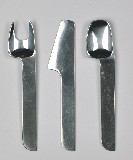 |
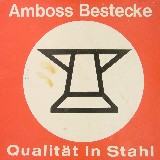 |
|
"Kinderbesteck 1060"
child's set,Josef Überall,
before 1970
|
Hors d'oevre set,
Dominic Habsburg-
Lothringen, before 1970
|
Prize-winning packaging
for Amboss flatware,
1968
|
In 1963, Amboss started to work with the German Rosenthal
group which became Amboss' new owner in 1969. Some Amboss
patterns were produced by Rosenthal under different names, for
instance 2050 became ABC, 2090 was now called Kontur and 2200
was called Austria. After 1976 Rosenthal transferred the
production of successful Amboss patterns to their German factory
and closed the Austrian premises. Many of the Amboss patterns
were sold, some to an Austrian investor, some to a former
Rosenthal employee who marked the new production of
2050/2060/2500 and 7000 with "Amboss Germany".
Heinrich Averwerser and Jörg Müller-Daehn have also mounted a
very interesting exhibition on all Amboss patterns at the
Solingen Klingenmuseum. For those who cannot visit, but want to
have further information about Amboss, there is a richly
illustrated catalogue of the exhibition (note
4) available from the authors directly. Just email your
order to heinrich.averwerser@gmx.de. The team Averwerser/Müller-Daehn
is already at work on a new project, a book sponsored by the
Solingen Klingenmuseum about German flatware from 1945 - 2000
comprising about 400 illustrations to be published in 2012.
While the Solingen flatware collectors' meeting is a very
exciting event for its interesting lectures and the opportunity
to meet with collectors, dealers and experts from many different
countries, a visit to the Solingen Klingenmuseum is a rewarding
experience at any time, as it not only has the largest
collection of flatware worldwide but also houses the Pott
Archives and the Collection Marquardt and mounts many
interesting exhibitions year-round.
All photos courtesy of William P. Hood Jr, and Heinrich
Averwerser
Dorothea Burstyn is the Editor of the Silver Society
of Canada Journal
and Administrator of SSC website
http://www.silversocietyofcanada.ca
- 2010 -
|
|
|
 ASSOCIATION OF SMALL COLLECTORS OF ANTIQUE SILVER
ASSOCIATION OF SMALL COLLECTORS OF ANTIQUE SILVER













